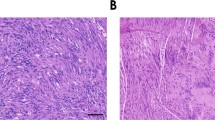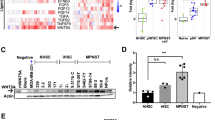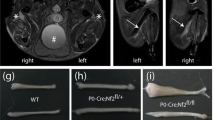Abstract
Peripheral nerve sheath tumors from individuals with Neurofibromatosis Type 1 (NF1) are highly vascular and contain Schwann cells which are deficient in neurofibromin. This study examines the angiogenic expression profile of neurofibromin-deficient human Schwann cells relative to normal human Schwann cells, characterizing both pro-angiogenic and anti-angiogenic factors. Conditioned media from neurofibromin-deficient Schwann cell lines was pro-angiogenic as evidenced by its ability to stimulate endothelial cell proliferation and migration. Using gene array and protein array analysis, we found increased expression of pro-angiogenic factors and decreased expression of anti-angiogenic factors in neurofibromin-deficient Schwann cells relative to normal human Schwann cells. Neurofibromin-deficient Schwann cells also showed increased expression of several growth factor receptors and decreased expression of an integrin. We conclude that neurofibromin-deficient Schwann cells have dysregulated expression of pro-angiogenic factors, anti-angiogenic factors, growth factor receptors, and an integrin. These dysregulated molecules may contribute to the growth and progression of NF1 peripheral nerve sheath tumors.




Similar content being viewed by others
References
Friedman JM (1999) Clinical genetics. In: Friedman JM, Gutmann DH, MacCollin M, Riccardi VM (eds) Neurofibromatosis: phenotype, natural history, and pathogenesis. The Johns Hopkins University Press, Baltimore, pp 110–118
Marchuk DA, Saulino AM, Tavakkol R et al (1991) cDNA cloning of the type 1 neurofibromatosis gene: complete sequence of the NF1 gene product. Genomics 11(4):931–940
Xu GF, O’Connell P, Viskochil D et al (1990) The neurofibromatosis type 1 gene encodes a protein related to GAP. Cell 62(3):599–608
Ballester R, Marchuk D, Boguski M et al (1990) The NF1 locus encodes a protein functionally related to mammalian GAP and yeast IRA proteins. Cell 63(4):851–859
Xu GF, Lin B, Tanaka K, et al (1990) The catalytic domain of the neurofibromatosis type 1 gene product stimulates ras GTPase and complements ira mutants of S. cerevisiae. Cell 63(4):835–841
Basu TN, Gutmann DH, Fletcher JA et al (1992) Aberrant regulation of ras proteins in malignant tumour cells from type 1 neurofibromatosis patients. Nature 356(6371):713–715
Angelov L, Salhia B, Roncari L et al (1999) Inhibition of angiogenesis by blocking activation of the vascular endothelial growth factor receptor 2 leads to decreased growth of neurogenic sarcomas. Cancer Res 59(21):5536–5541
Arbiser JL, Flynn E, Barnhill RL (1998) Analysis of vascularity of human neurofibromas. J Am Acad Dermatol 38(6 Pt 1):950–954
Lee JK, Choi B, Sobel RA et al (1990) Inhibition of growth and angiogenesis of human neurofibrosarcoma by heparin and hydrocortisone. J Neurosurg 73(3):429–435
Perrin GQ, Fishbein L, Thomson SA et al (2007) Benign Plexiform-like Neurofibromas Develop in the Mouse by Intraneural Xenograft of an NF1 Tumor-derived Schwann Cell Line. J Neurosci Res (in press)
Sheela S, Riccardi VM, Ratner N (1990) Angiogenic and invasive properties of neurofibroma Schwann cells. J Cell Biol 111(2):645–653
Hansson HA, Lauritzen C, Lossing C et al (1988) Somatomedin C as tentative pathogenic factor in neurofibromatosis. Scand J Plast Reconstr Surg Hand Surg 22(1):7–13
Krasnoselsky A, Massay MJ, DeFrances MC et al (1994) Hepatocyte growth factor is a mitogen for Schwann cells and is present in neurofibromas. J Neurosci 14(12):7284–7290
Mashour GA, Ratner N, Khan GA et al (2001) The angiogenic factor midkine is aberrantly expressed in NF1-deficient Schwann cells and is a mitogen for neurofibroma-derived cells. Oncogene 20(1):97–105
Rao UN, Sonmez-Alpan E, Michalopoulos GK (1997) Hepatocyte growth factor and c-MET in benign and malignant peripheral nerve sheath tumors. Hum Pathol 28(9):1066–1070
Ratner N, Lieberman MA, Riccardi VM et al (1990) Mitogen accumulation in von Recklinghausen neurofibromatosis. Ann Neurol 27(3):298–303
Folkman J (1992) The role of angiogenesis in tumor growth. Semin Cancer Biol 3(2):65–71
Casella GT, Bunge RP, Wood PM (1996) Improved method for harvesting human Schwann cells from mature peripheral nerve and expansion in vitro. Glia 17(4):327–338
Thomas SL, Deadwyler GD, Tang J et al (2006) Reconstitution of the NF1 GAP-related domain in NF1-deficient human Schwann cells. Biochem Biophys Res Commun 348(3):971–980
Kim HA, Ling B, Ratner N (1997) Nf1-deficient mouse Schwann cells are angiogenic and invasive and can be induced to hyperproliferate: reversion of some phenotypes by an inhibitor of farnesyl protein transferase. Mol Cell Biol 17(2):862–872
Dhawan P, Richmond A (2002) Role of CXCL1 in tumorigenesis of melanoma. J Leukoc Biol 72(1):9–18
Lazar-Molnar E, Hegyesi H, Toth S et al (2000) Autocrine and paracrine regulation by cytokines and growth factors in melanoma. Cytokine 12(6):547–54
Payne AS, Cornelius LA (2002) The role of chemokines in melanoma tumor growth and metastasis. J Invest Dermatol 118(6):915–922
Streit M, Detmar M (2003) Angiogenesis, lymphangiogenesis, and melanoma metastasis. Oncogene 22(20):3172–3179
Lacal PM, Failla CM, Pagani E et al (2000) Human melanoma cells secrete and respond to placenta growth factor and vascular endothelial growth factor. J Invest Dermatol 115(6):1000–1007
Kawachi Y, Xu X, Ichikawa E et al (2003) Expression of angiogenic factors in neurofibromas. Exp Dermatol 12(4):412–417
Lee PR, Cohen JE, Tendi EA et al (2004) Transcriptional profiling in an MPNST-derived cell line and normal human Schwann cells. Neuron Glia Biol 1:135–147
Watanabe T, Oda Y, Tamiya S, et al (2001) Malignant peripheral nerve sheath tumour arising within neurofibroma. An immunohistochemical analysis in the comparison between benign and malignant components. J Clin Pathol 54(8):631–636
Miller SJ, Rangwala F, Williams J et al (2006) Large-scale molecular comparison of human Schwann cells to malignant peripheral nerve sheath tumor cell lines and tissues. Cancer Res 66(5):2584–2591
Watson MA, Perry A, Tihan T et al (2004) Gene expression profiling reveals unique molecular subtypes of Neurofibromatosis Type I-associated and sporadic malignant peripheral nerve sheath tumors. Brain Pathol 14:297–303
Riccardi VM (1981) Cutaneous manifestation of neurofibromatosis: cellular interaction, pigmentation, and mast cells. Birth Defects Orig Artic Ser 17(2):129–145
Riccardi VM (1987) Mast-cell stabilization to decrease neurofibroma growth. Preliminary experience with ketotifen. Arch Dermatol 123(8):1011–1016
Yang FC, Ingram DA, Chen S et al (2003) Neurofibromin-deficient Schwann cells secrete a potent migratory stimulus for Nf1+/− mast cells. J Clin Invest 112(12):1851–1861
Zhu Y, Ghosh P, Charnay P et al (2002) Neurofibromas in NF1: Schwann cell origin and role of tumor environment. Science 296(5569):920–922
Duffy MJ, Maguire TM, McDermott EW et al (1999) Urokinase plasminogen activator: a prognostic marker in multiple types of cancer. J Surg Oncol 71(2):130–135
Mazar AP, Henkin J, Goldfarb RH (1999) The urokinase plasminogen activator system in cancer: implications for tumor angiogenesis and metastasis. Angiogenesis 3(1):15–32
Bu X, Khankaldyyan V, Gonzales-Gomez I et al (2004) Species-specific urokinase receptor ligands reduce glioma growth and increase survival primarily by an antiangiogenesis mechanism. Lab Invest 84(6):667–678
Gondi CS, Lakka SS, Yanamandra N et al (2003) Expression of antisense uPAR and antisense uPA from a bicistronic adenoviral construct inhibits glioma cell invasion, tumor growth, and angiogenesis. Oncogene 22(38):5967–5975
McGuire PG, Jones TR, Talarico N et al (2003) The urokinase/urokinase receptor system in retinal neovascularization: inhibition by A6 suggests a new therapeutic target. Invest Ophthalmol Vis Sci 44(6):2736–2742
Oh CW, Hoover-Plow J, Plow EF (2003) The role of plasminogen in angiogenesis in vivo. J Thromb Haemost 1(8):1683–1687
Siren V, Antinheimo JP, Jaaskelainen J et al (2004) Plasminogen activation in neurofibromatosis 2-associated and sporadic schwannomas. Acta Neurochir (Wien) 146(2):111–118
Muir D (1995) Differences in proliferation and invasion by normal, transformed and NF1 Schwann cell cultures are influenced by matrix metalloproteinase expression. Clin Exp Metastasis 13(4):303–314
Chlenski A, Liu S, Crawford SE et al (2002) SPARC is a key Schwannian-derived inhibitor controlling neuroblastoma tumor angiogenesis. Cancer Res 62(24):7357–7363
Huang D, Rutkowski JL, Brodeur GM et al (2000) Schwann cell-conditioned medium inhibits angiogenesis. Cancer Res 60(21):5966–5971
Funk SE, Sage EH (1991) The Ca2(+)-binding glycoprotein SPARC modulates cell cycle progression in bovine aortic endothelial cells. Proc Natl Acad Sci USA 88(7):2648–2652
Kupprion C, Motamed K, Sage EH (1998) SPARC (BM-40, osteonectin) inhibits the mitogenic effect of vascular endothelial growth factor on microvascular endothelial cells. J Biol Chem 273(45):29635–29640
Motamed K, Funk SE, Koyama H et al (2002) Inhibition of PDGF-stimulated and matrix-mediated proliferation of human vascular smooth muscle cells by SPARC is independent of changes in cell shape or cyclin-dependent kinase inhibitors. J Cell Biochem 84(4):759–771
Rempel SA, Golembieski WA, Fisher JL et al (2001) SPARC modulates cell growth, attachment and migration of U87 glioma cells on brain extracellular matrix proteins. J Neurooncol 53(2):149–160
Schultz C, Lemke N, Ge S, Golembieski WA et al (2002) Secreted protein acidic and rich in cysteine promotes glioma invasion and delays tumor growth in vivo. Cancer Res 62(21):6270–6277
Badache A, De Vries GH (1998) Neurofibrosarcoma-derived Schwann cells overexpress platelet-derived growth factor (PDGF) receptors and are induced to proliferate by PDGF BB. J Cell Physiol 177(2):334–342
Holtkamp N, Mautner VF, Friedrich RE et al (2004) Differentially expressed genes in neurofibromatosis 1-associated neurofibromas and malignant peripheral nerve sheath tumors. Acta Neuropathol (Berl) 107(2):159–168
DeClue JE, Heffelfinger S, Benvenuto G et al (2000) Epidermal growth factor receptor expression in neurofibromatosis type 1- related tumors and NF1 animal models. J Clin Invest 105(9):1233–1241
Deng C, Wynshaw-Boris A, Zhou F et al (1996) Fibroblast growth factor receptor 3 is a negative regulator of bone growth. Cell 84(6):911–921
Wilkie AO, Patey SJ, Kan SH et al (2002) FGFs, their receptors, and human limb malformations: clinical and molecular correlations. Am J Med Genet 112(3):266–278
Soker S, Takashima S, Miao HQ et al (1998) Neuropilin-1 is expressed by endothelial and tumor cells as an isoform-specific receptor for vascular endothelial growth factor. Cell 92(6):735–745
Marshall JF, Hart IR (1996) The role of alpha v-integrins in tumour progression and metastasis. Semin Cancer Biol 7(3):129–138
Eliceiri BP, Cheresh DA (2000) Role of alpha v integrins during angiogenesis. Cancer J 6(suppl 3):S245–249
Acknowledgments
We are grateful to Dr. Patrick Wood for providing the human peripheral nerve and Dr. David Muir for providing the NF1 tumor-derived Schwann cell lines. We thank Dr. Ian Dang for his guidance. We also thank Jean Egerman and Susan MacPhee-Gray for editorial assistance. S.L. Thomas was supported by a fellowship from the Arthur J. Schmitt Foundation. This work was supported by grants from Illinois NF, Inc. and Minnesota NF, Inc.
Author information
Authors and Affiliations
Corresponding author
Rights and permissions
About this article
Cite this article
Thomas, S.L., De Vries, G.H. Angiogenic Expression Profile of Normal and Neurofibromin-Deficient Human Schwann Cells. Neurochem Res 32, 1129–1141 (2007). https://doi.org/10.1007/s11064-007-9279-z
Received:
Accepted:
Published:
Issue Date:
DOI: https://doi.org/10.1007/s11064-007-9279-z




